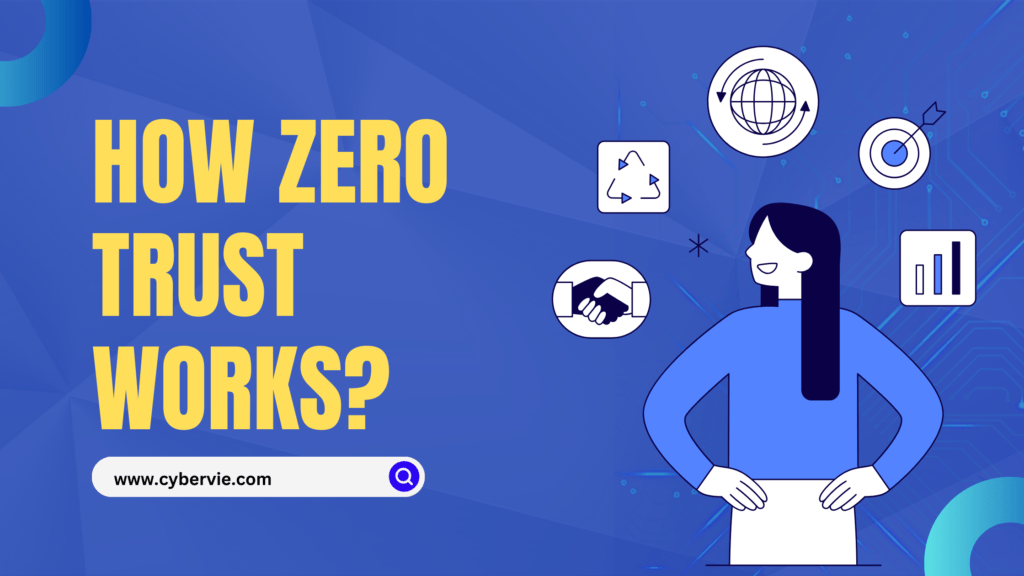Zero Trust Architecture for Enhancing Data Security
Introduction
Zero trust works on the principle of “never believe, always verify” rather than providing implicit trust for all users in the network. This granular approach to security helps address cybersecurity risks posed by remote workers, hybrid cloud services, privately owned devices, and other components of today’s enterprise networks
An increasing number of organizations are leveraging distrust models to increase their attack availability and improve their security posture. According to the 2024 Tech Target Enterprise Strategy Group report, more than two-thirds of organizations say they have no-trust policies in place
The Need For Zero Trust Architecture
The zero-trust approach is important because traditional network security measures are not sufficient. Zero trust strategies are designed for the complex, highly distributed networks that most organizations use today.
For years, enterprises have focused on surrounding their networks with firewalls and other security measures. Within the network, users were considered trustworthy and were granted access to applications, data, and resources.
The digital revolution ended the traditional concept of the web perimeter. Today, corporate networks are expanding beyond office spaces and network segments. Modern company ecosystems encompass cloud environments, cellular packages, information centers, IoT devices, software program-as-a-carrier (SaaS) apps, and far-flung access for employees, companies, and agencies they work with.
These elevated assaults make groups extra at risk of records breaches, ransomware, insider threats, and different styles of cyberattacks. There are no clear, unbroken lines around the net, and the defenses around it can’t close any gaps. Additionally, threat actors who gain access to the network can use implicit authentication to backtrack and attack sensitive resources.
Every endpoint, user, and connection request is considered a potential risk. Instead of giving them unbiased authority as they circulate, users need to be authenticated and certified every time they hook up with a new item.
This continuous validation ensures that the best legitimate users can get entry to valuable community belongings.
How Zero Trust Works?

In the broadest sense, a zero-trust security seal works by continuously monitoring and validating communications between users, applications, devices, and data.
Implementing a gyro trust system throughout an organization can be a daunting task. There is no problem with establishing a single solution with uncertainty. Seamless authentication requires planning and implementation across multiple enterprise domains, including access design, security solutions and workflows, automation, applications, and network infrastructure
Many organizations follow a common no-trust policy to build a trust-free system. Established models include Forrester’s Zero Trust Framework, the National Institute of Standards and Technology (NIST) Special Document (SP) 800-2073, and the Cybersecurity Infrastructure Security Agency (CISA) Zero Trust Maturity Model (ZTMM).
While organizations can choose from a variety of policies, most mistrust strategies share these basic concepts: three principles of mistrust, five pillars of mistrust, and mistrust communication (ZTNA).
What Are The Three Principles Of Zero Trust?
The technical specs of various frameworks and fashions can vary, however, all of them follow a middle set of zero-trust standards:
1. Continuous Monitoring and Validation
Zero trust way no network belongings are reachable via default. Users, gadgets, and workloads must constantly authenticate and validate to access sources, and they have to skip those exams every time they request a connection.
Dynamic access control guidelines determine whether to approve requests based on records factors inclusive of consumer privileges, area, device fitness, threat intelligence, and uncommon behavior. Connections are continuously monitored and must be periodically reauthenticated to maintain the consultation.
2. The Principle of Least Privilege
In a zero trust setup, users and devices get the least get right of entry needed to do their task. In this approach they acquire best the permissions required to finish an assignment or position, which are revoked when the consultation ends.
This approach limits risk actors’ capacity to get admission to different areas of the network.
3. Assume Breach
In zero trust, protection teams function below the assumption that hackers have already breached the community. Actions normally used to mitigate ongoing cyberattacks become trendy methods. These consist of segmenting the community to contain assaults, monitoring every asset, user, device, and method, and responding to unusual behaviors in actual time.
What Are The Five Pillars Of Zero Trust?
CISA’s Zero Trust Security Model outlines4 five pillars that organizations can focus on during a zero trust implementation:
1. Identity
Authenticating consumer identities and granting those users get entry to only to permitted employer sources is a fundamental functionality of zero trust safety.
Common gear that businesses use for this reason consists of identity and access management (IAM) structures, single signal-on (SSO) solutions, and multifactor authentication (MFA)
2. Devices
Every device that connects to a network useful resource ought to be compliant with the zero-consider rules and safety controls of the agency. This consists of workstations, cell phones, servers, laptops, IoT devices, printers and others.
Zero trust with groups that hold entire and cutting-edge inventories of all legal endpoint gadgets. Unauthorized devices are denied network get entry to.
3. Networks
Organizations pass from conventional community segmentation to micro-segmentation in zero turst surroundings. Resources and workloads are separated into smaller, greater stable zones, which help corporations include breaches and prevent lateral motion. Threat actors cannot even see sources they may be now not authorized to use.
Organizations may also install other community risk prevention strategies, such as encrypting network traffic and tracking user and entity behaviors.
4. Applications and Workloads
As with every unique element in a zero trust protection model, programs and alertness programming interfaces (APIs) now do not have implicit trust.
Instead of supplying one-time, static get right of access to applications, businesses skip to dynamic authorization that requires continual re validation for chronic get proper of access. Organizations constantly screen applications that speak to each one-of-a-kind for uncommon behavior.
5. Data
Under a zero-trust model, organizations categorize their information so that you can have a look at targeted access control and record security guidelines to defend information.
Data in transit, in use, and at rest is protected with the resource of encryption and dynamic authorization. Organizations constantly show data processing for unusual hobbies that would advocate information breaches or exfiltration of touchy data.
What Is Zero Trust Network Access (Ztna)?
One key technology to implement a zero-trust policy is zero-trust network access or ZTNA. Like a virtual private network (VPN), ZTNA provides remote access to applications and services. Unlike VPN, ZTNA connects users only to resources they are allowed to access rather than to the entire network.
ZTNA is an integral part of the Secure Area Service Edge (SASE) model, which enables enterprises to provide direct, secure, low-voltage connections between users and resources.
Why Implement Zero Trust Solutions?
Your business gives more users access to your company’s products. Despite the different goals and needs of these employees, partners, clients, and clients, they all need access to corporate information in some form. The number of transactions and objects to manage complicates user loyalty.
Going on a hybrid multi-cloud infrastructure means your resources are also dispersed across many different IT environments, with many different endpoints including IoT devices, with different levels of visibility and control It’s hard to tell if a user the qualifier has the right access to the right data. You need relevant information to help you make good decisions.
Equally concerning is the proliferation of malicious activity, such as malware, ransomware, and phishing, which threatens your network, digital assets, and business According to the IBM Cost of Data Breach Report, costs have increased 15% in 3 years in the past.
Use Cases For Zero Trust
There are multiple use cases for zero-trust architecture:
- Multicloud Security: Zero trust architecture, which controls access primarily based on identity, gives sturdy security for hybrid and multi-cloud environments. Authorized cloud workloads get get right of entry to to vital assets, at the same time as unauthorized ones are denied access. No count the source, region, or IT infrastructure adjustments, 0 agree with reliably protecting busy cloud environments.
- Supply Chain Security: Organizations want to provide networks to get the right of entry to to companies, contractors, and different third events. Hackers take advantage of this through the use of compromised dealer accounts to infiltrate an employer’s community. Zero accept as true makes use of continuous, contextual authentication and least-privilege access for each entity, consisting of outside ones. Even if hackers compromise a seller’s account, they cannot get the right of entry to the company’s most touchy sources.
- Remote Access for Employees: Traditionally, companies use digital personal networks (VPNs) for far-flung employees to get the right of entry. However, VPNs don’t scale properly and cannot save you lateral motion. In a zero-trust version, agencies use Zero-Trust Network Access (ZTNA) solutions. ZTNA verifies employee identities and grants admission to the most effective packages, facts, and services wished for their jobs.
- IoT Visibility: IoT gadgets, which hook up to the net, may be a protection danger. Hackers often goal to introduce malware into vulnerable community structures.
Conclusion
Zero trust architectures continuously track the area, reputation, and fitness of every IoT tool throughout a corporation. Each device is handled as a probably malicious entity.
As with other factors of a zero trust environment, IoT devices are concerned with getting entry to controls, authentication, and encrypted communications with different network sources.
Implementing Zero Trust Architecture (ZTA) is important for modern-day cybersecurity. By continuously validating customers, gadgets, and connections, ZTA mitigates risks like fact breaches and ransomware.
Core principles and technology which include Zero Trust Network Access (ZTNA) ensure robust, granular protection, improving security and compliance in these days’s complex digital environments.
Are you ready to implement Zero Trust Architecture in your business? Check out Cybervie today!
References:
https://www.ibm.com/zero-trust
https://securityintelligence.com/tag/zero-trust/
https://www.ibm.com/blog/the-evolution-of-zero-trust-and-the-frameworks-that-guide-it/
https://mediacenter.ibm.com/media/Zero+Trust+Explained+in+4+mins/1_0inosenb









